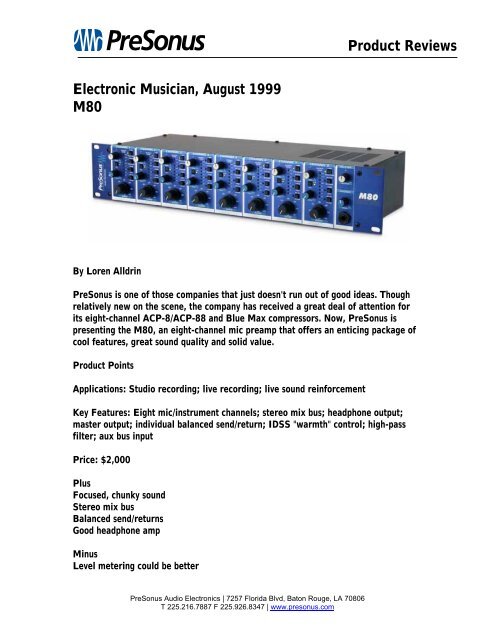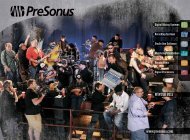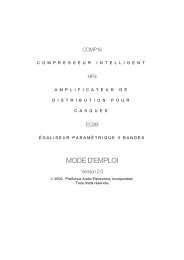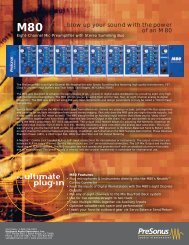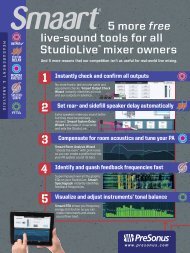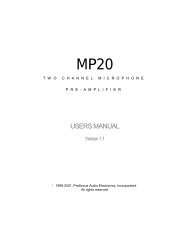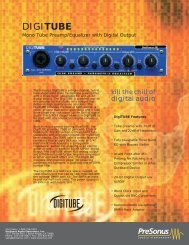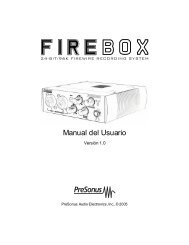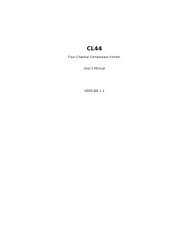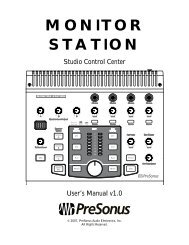EM M80 review Aug99 - PreSonus
EM M80 review Aug99 - PreSonus
EM M80 review Aug99 - PreSonus
You also want an ePaper? Increase the reach of your titles
YUMPU automatically turns print PDFs into web optimized ePapers that Google loves.
Product Reviews<br />
Electronic Musician, August 1999<br />
<strong>M80</strong><br />
By Loren Alldrin<br />
<strong>PreSonus</strong> is one of those companies that just doesn't run out of good ideas. Though<br />
relatively new on the scene, the company has received a great deal of attention for<br />
its eight-channel ACP-8/ACP-88 and Blue Max compressors. Now, <strong>PreSonus</strong> is<br />
presenting the <strong>M80</strong>, an eight-channel mic preamp that offers an enticing package of<br />
cool features, great sound quality and solid value.<br />
Product Points<br />
Applications: Studio recording; live recording; live sound reinforcement<br />
Key Features: Eight mic/instrument channels; stereo mix bus; headphone output;<br />
master output; individual balanced send/return; IDSS "warmth" control; high-pass<br />
filter; aux bus input<br />
Price: $2,000<br />
Plus<br />
Focused, chunky sound<br />
Stereo mix bus<br />
Balanced send/returns<br />
Good headphone amp<br />
Minus<br />
Level metering could be better<br />
<strong>PreSonus</strong> Audio Electronics | 7257 Florida Blvd, Baton Rouge, LA 70806<br />
T 225.216.7887 F 225.926.8347 | www.presonus.com
Product Reviews<br />
Large external power supply<br />
The Score<br />
An affordable multichannel preamp with an aggressive sound and some useful added<br />
features.<br />
Features<br />
The <strong>M80</strong> ($2,000) is an eight-channel mic/instrument preamp in a two-rack-space<br />
package. Each channel uses a combo Neutrik input jack that offers both XLR mic<br />
and 1/4" instrument inputs. The inputs boast a Jensen transformer and Class-A FET<br />
electronics (with "NO capacitors," as the manual proudly states).<br />
Each input has balanced send and return jacks (a rarity at this price point) and a<br />
balanced XLR output. You can use the balanced send as a 1/4" output, and the<br />
balanced return as a 1/4" line level input. The manual doesn't state the operating<br />
level of these jacks.<br />
The <strong>M80</strong> has a few other inputs and outputs as well, thanks to its stereo mix bus. A<br />
pair of XLR jacks carry the stereo output, with their level controlled by the <strong>M80</strong>'s<br />
master output knob. Also tapped off the stereo bus is the <strong>M80</strong>'s headphone output,<br />
with a 1/4" jack and level control mounted on the front panel. A pair of XLR inputs<br />
allow you to route a stereo source (mixer, stereo playback deck, another <strong>M80</strong>) right<br />
to the <strong>M80</strong>'s stereo bus.<br />
Out front, the <strong>M80</strong> is bristling with controls. Each input has phantom power, phase<br />
reverse, 20 dB pad and 80 Hz high-pass filter switches. A large gain knob goes from<br />
0 dB to 60 dB, with the gain setting marked off in easy-to-read 10 dB steps. A L/R<br />
switch assigns a given input to the stereo bus; just above it is a pan control that<br />
places that input in the stereo field.<br />
The last input channel knob is the IDSS control, which goes from 0% to 100%. This<br />
knob tweaks the input transistor circuit to generate harmonic distortion. These<br />
harmonics are not unlike those generated by mildly overdriven tube circuitry or<br />
analog tape, earning this knob the tired audio cliché’ "warmth" in <strong>PreSonus</strong>' manual<br />
and marketing materials.<br />
Finally, each channel of the <strong>M80</strong> has an eight-segment LED meter that tracks its<br />
output level. These LEDs are calibrated in 9 dB steps from - 36 dB to + 18 dB, with<br />
the top red LED lighting just before clipping (the manual doesn't state where). There<br />
are no output level or peak meters for the stereo bus, which makes summing very hot<br />
input signals a bit of a risk. Thankfully, the <strong>M80</strong> has lots of headroom (maximum<br />
output level is specified at +28 dBu).<br />
In use<br />
<strong>PreSonus</strong> Audio Electronics | 7257 Florida Blvd, Baton Rouge, LA 70806<br />
T 225.216.7887 F 225.926.8347 | www.presonus.com
Product Reviews<br />
Testing mic preamps is always an enjoyable challenge, because their sonic<br />
differences can be very subtle. It didn't take long, however, to detect the <strong>M80</strong>'s sonic<br />
fingerprint. The <strong>PreSonus</strong> imparts a favorable coloration that takes it out of the<br />
realm of the ultra-transparent, clinically clean preamps. For most types of recording,<br />
I favor a preamp with some character.<br />
With the IDSS control set to minimum, the <strong>M80</strong> has what I would call a "focused"<br />
sound. In contrast to preamps that sound extremely open and airy, the <strong>PreSonus</strong> has<br />
a compact, aggressive sound. Its forward-sounding midrange has a little bit of edge to<br />
it, which I really like. You could almost say the <strong>M80</strong> sounds tough.<br />
The preamp captures plenty of detail, but its top end doesn't sound overly extended<br />
or hyped (in spite of hitting 60 kHz at just 0.5 dB down). One vocalist/mic<br />
combination that was too sibilant with another mic preamp sounded much more<br />
pleasing through the <strong>M80</strong>. Likewise, a mic I thought was too bright on an acoustic<br />
guitar sounded much better through the <strong>M80</strong>.<br />
Roll the IDSS control on, and the <strong>M80</strong> takes on a different character. Up to about<br />
80% throttle, the ear perceives a very slight loss of top end and a thickening of the<br />
low mids. Set to maximum, the IDSS control chops the perceived high-end response<br />
noticeably. Gain seems to drop a bit, and the low end really fills out. Higher IDSS<br />
settings even flatten out dynamics a little, which can be a nice effect.<br />
It may seem odd that an increase in harmonic distortion would cause a perceived<br />
dulling of the sound, but that's definitely what my ears heard. I found the <strong>M80</strong> to be<br />
chunky enough without the IDSS circuit engaged, though, and I preferred the<br />
uncolored setting for all but the brightest mic or sound source.<br />
In contrast to gear with the hard-to-use Euro-cool vibe, I appreciate the <strong>M80</strong>'s nononsense<br />
controls. Gain is smooth and predictable across the whole range, the<br />
constant-power pan controls feel great, and switches are easy to find and engage.<br />
The <strong>M80</strong>'s mix bus opens up countless new applications. You can plug phones into the<br />
front of the <strong>M80</strong> and use the L/R assign buttons like solo controls for monitoring.<br />
You can combine and pan top- and bottom-head snare mics to one output, or combine<br />
toms and overheads before recording. Put a guide mix on one channel of an ADAT or<br />
HD recorder, grab the <strong>M80</strong> and a handful of mics and record your favorite drummer<br />
in his living room. Mic up a choir or string section or whatever and record on-the-spot<br />
to stereo. The possibilities are endless.<br />
Headphone amps can be an afterthought on a product like this, but <strong>PreSonus</strong> has<br />
equipped the <strong>M80</strong> with a good one. It has enough power to drive even stubborn highimpedance<br />
phones to respectable levels, and sounds very good.<br />
<strong>PreSonus</strong> Audio Electronics | 7257 Florida Blvd, Baton Rouge, LA 70806<br />
T 225.216.7887 F 225.926.8347 | www.presonus.com
Product Reviews<br />
Complaints? Eight LEDs worth of metering per channel is a real plus, but I would<br />
have appreciated a little finer resolution where it really matters. LEDs at -9 dB, 0<br />
dB and +9 dB are all you get, making the metering of little use for actual recording<br />
(especially with a digital recorder). A signal present indicator around -50 dB plus a<br />
cluster of LEDs around 0 dB might have been a better approach.<br />
The test unit shipped with a huge outboard power supply, easily the largest I've seen<br />
on anything short of a mixing console. It connects to the <strong>M80</strong> with a clunky locking<br />
nut that feels none too sturdy. According to <strong>PreSonus</strong>, the original internal supply<br />
design compromised noise performance, so the company went with the large<br />
outboard unit.<br />
Summary<br />
The <strong>M80</strong> is what I would call a microphone power tool. It gives you eight channels of<br />
no-fuss gain, a convenient mix bus and flexible I/O. The IDSS circuit may come in<br />
handy now and then, but I wouldn't buy the <strong>M80</strong> for it.<br />
Instead, I'd give the <strong>M80</strong> serious consideration because it's a great-sounding,<br />
feature-packed preamp that will set you back less than 300 bucks a channel. Check it<br />
out.<br />
<strong>PreSonus</strong> Audio Electronics | 7257 Florida Blvd, Baton Rouge, LA 70806<br />
T 225.216.7887 F 225.926.8347 | www.presonus.com


